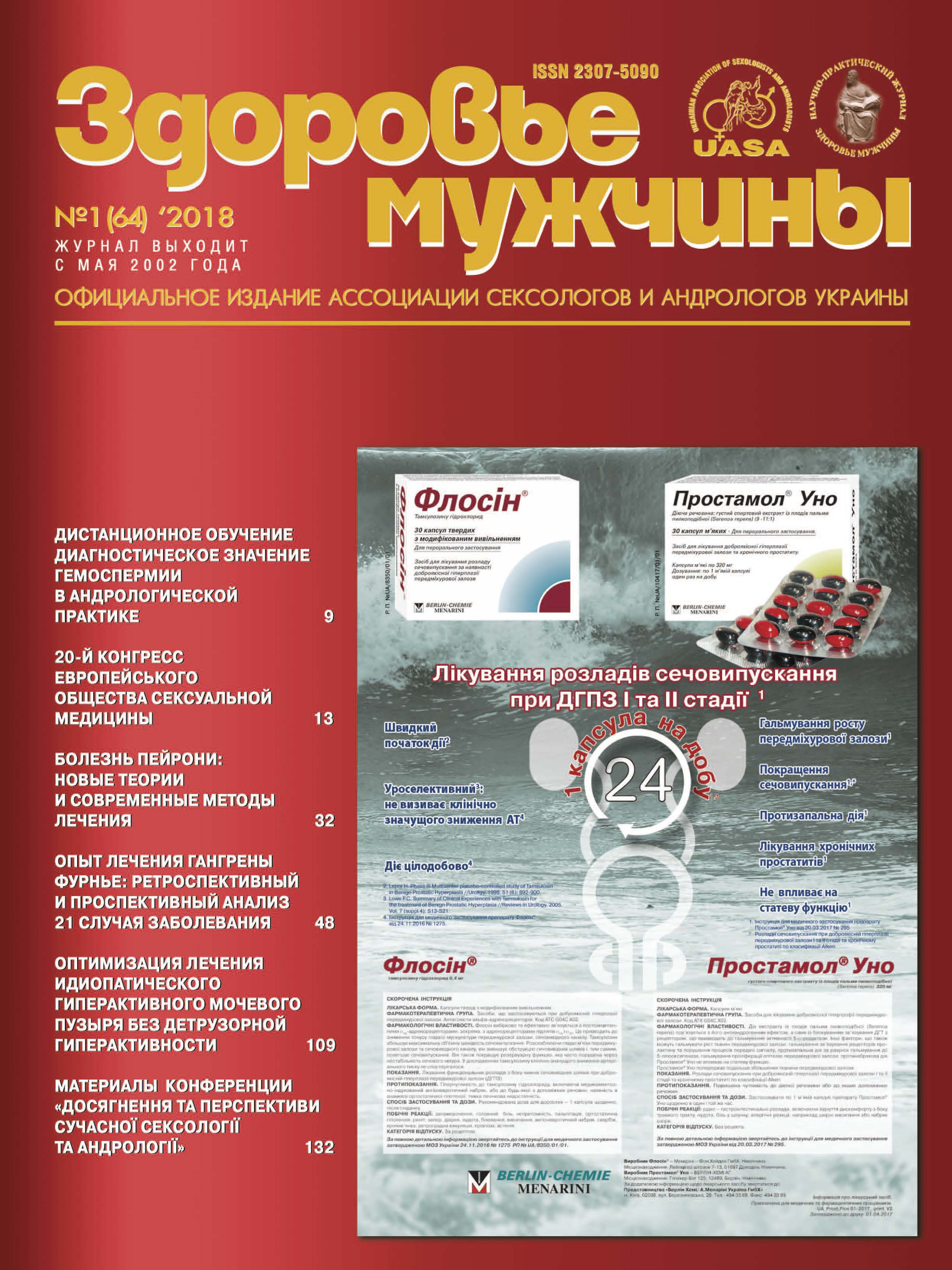Optimization of treatment idiopathic overactive bladder without detrusor overactivity
##plugins.themes.bootstrap3.article.main##
Abstract
The objective: was to evaluate the effectiveness of monotherapy with competitive antagonist M-cholinoreceptors with tolterine tartrate and its purpose in combination with cyclic structural analogue of g-aminobutyric acid gabapentin in patients with idiopathic hyperactive bladder (IGAMP) without detrusor hyperactivity (DG).
Materials and methods. The study involved 63 patients with IGAMP with urodynamically proven absence of DG (14 men and 49 women). Patients were divided into two groups: group A – 31 patients and group B – 32 patients. According to the design of the study patients of group A were prescribed therapy as a competitive antagonist of M-cholinergic receptors, which are localized in MP, – tolterodine tartrate. Group B patients used combination therapy with tolterodine tartrate and a medicinal form from the group of anticonvulsants – gabapentin. This choice of drugs is determined by the desire to effect a double effect on the lower urinary tract: eliminate both the sensory and the reflex component of the pathogenesis of urgent urination.
Results. Analysis of the results of the use of anticholinergic monotherapy in group A made it possible to ascertain that, in general, this type of treatment does not lead to a significant improvement in the symptoms of urgent, frequent urination in patients with IGAMP without DG. But among the patients of group B, by the end of the 8th week of therapy there were 12 (37.50%) patients who achieved a 50% or greater reduction in the incidence of IGAMP symptoms.
Conclusions. It was found that monotherapy in these patients is of low efficacy and is realized mainly due to a decrease in the frequency of urination per day (by 37.55%) and the frequency of incontinence episodes (by 52.14%), and to a lesser extent due to a decrease in the intensity of urgency (by 14.8%). Combination therapy allows for more effective elimination of the main objective and subjective symptoms of the disease, which manifests in a decrease in the frequency of pollakiuria by 64.17%, nocturia by 82.18%, urgency at 81.40% and urinary incontinence by 80.66%.##plugins.themes.bootstrap3.article.details##

This work is licensed under a Creative Commons Attribution 4.0 International License.
Authors retain the copyright and grant the journal the first publication of original scientific articles under the Creative Commons Attribution 4.0 International License, which allows others to distribute work with acknowledgment of authorship and first publication in this journal.
References
Gormley EA; Lightner DJ; Faraday M; Vasavada SP (May 2015). «Diagnosis and Treatment of Overactive Bladder (Non Neurogenic) in Adults: AUA/SUFU Guideline Amendment». The Journal of Urology. 193(5): 1572–80. https://doi.org/10.1016/j.juro.2015.01.087
Thüroff JA, Abrams P, Andersson KE, et al. EAU guidelines on urinary incontinence. Eur Urol. 2011 Mar; 59(3):387–400. https://doi.org/10.1016/j.eururo.2010.11.021
Lee YS, Lee KS, Jung JH, Han DH, Oh SJ, Seo JT, et al. Prevalence of overactive bladder, urinary incontinence, and lower urinary tract symptoms: results of Korean EPIC study. World J Urol 2011;29:185–190. https://doi.org/10.1007/s00345-009-0490-1
Kyu Shik Kim, Hong Sang Moon. Antimuscarinic agent treatment affecting patient-reported outcomes in overactive bladder syndrome with depressive symptoms. Int Neurourol J. 2016;20(4):349–355. https://dx.doi.org/10.5213%2Finj.1624678.339
Yuriy M. Dekhtiar, Fedir I. Kostyev, Oleksandr V. Rudenko, Dmytro O. Kuznietsov. Urodynamic patterns of the idiopathic overactive bladder. Science Journal of Clinical Medicine 2017; 6(5): 74–79. http://dx.doi.org/10.11648/j.sjcm.20170605.12





